HOME | Continue HHR TOUR | SHEPLEY | UNION STATION | ADAMS | KS OMANESQUE | CORNERS | GALVESTON | FOR |
Looming over Trinity is the infamous Hancock Tower. Much controversy surrounded the construction of the tower. The weight of the building caused problems for the foundations of surrounding buildings, including Trinity. At right is detail from the porch, added after Richardson's death by his successors, Shepley, Rutan & Coolidge. |
The Great Boston Fire of 1872 destroyed much of the downtown area. The fire burned for three days. Fire brigades from as far away as Maine were called in to help out since the local horse population (used to draw the fire apparatus) had recently been decimated by disease. Phillips Brooks' Gothic-style Trinity Church was one of the many destroyed buildings. The congregation bought a parcel of land in the then still developing Back Bay. Richardson won the competition to design and build the new church. Construction began in April, 1873. Richardson brought in John LaFarge to do the interior decoration. The new building was consecrated in February, 1877. Working on Richardson's staff was budding architect Stanford White. In 1879 White would partner with Charles Follen McKim (who had also worked for Richardson) and William Rutherford Mead to create the famous New York firm of McKim, Mead & White. Twenty years later McKim, Mead & White would complete constrution of the new Boston Public Library, opposite Trinity. Phillip Johnson would later design an addition to the library. Johnson & John Burgee designed the building directly behind Trinity. |
After graduation from Harvard, Richardson went to Paris to study architecture at the Ecole des Beaux-Arts. He was only the second American, after Richard Morris Hunt, to be formally trained in architecture. The Civil War kept Richardson in Paris. After the war he moved to New York and in 1867 partnered with architect Charles Dexter Gambrill. He and his new wife, Julia Gorham Hayden lived on Staten Island until 1874. |
The Architecture of Henry Hobson Richardson |
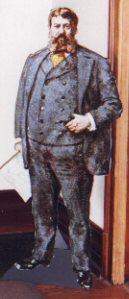
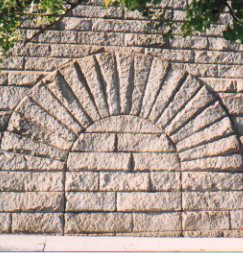
Do you know where this is? |
H.H. Richardson was born in Louisiana on September 29, 1838, a descendant on his mother's side of Joseph Priestley. He spent his early life in New Orleans and on the Priestley plantation.. In 1856, HHR came to Harvard to study. While his academic career was nothing to brag about, he did manage to make contacts that would sustain his architectural career throughout the remainder of his short life. |
After graduation from Harvard, Richardson went to Paris to study architecture at the Ecole des Beaux-Arts. He was only the second American, after Richard Morris Hunt, to be formally trained in architecture. The Civil War kept Richardson in Paris. After the war he moved to New York and in 1867 partnered with architect Charles Dexter Gambrill. He and his new wife, Julia Gorham Hayden lived on Staten Island until 1874. |
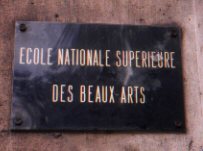
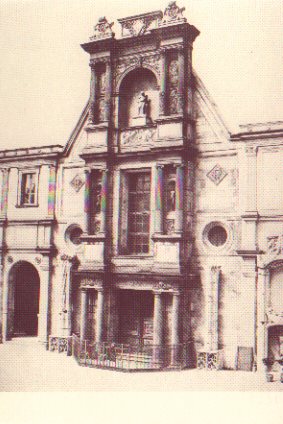
The Great Boston Fire of 1872 destroyed much of the downtown area. The fire burned for three days. Fire brigades from as far away as Maine were called in to help out since the local horse population (used to draw the fire apparatus) had recently been decimated by disease. Phillips Brooks' Gothic-style Trinity Church was one of the many destroyed buildings. The congregation bought a parcel of land in the then still developing Back Bay. Richardson won the competition to design and build the new church. Construction began in April, 1873. Richardson brought in John LaFarge to do the interior decoration. The new building was consecrated in February, 1877. Working on Richardson's staff was budding architect Stanford White. In 1879 White would partner with Charles Follen McKim (who had also worked for Richardson) and William Rutherford Mead to create the famous New York firm of McKim, Mead & White. Twenty years later McKim, Mead & White would complete constrution of the new Boston Public Library, opposite Trinity. Phillip Johnson would later design an addition to the library. Johnson & John Burgee designed the building directly behind Trinity. |
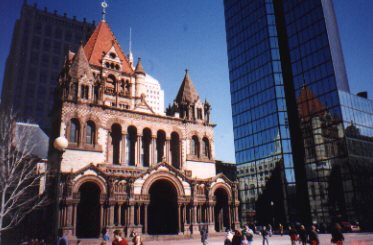
Looming over Trinity is the infamous Hancock Tower. Much controversy surrounded the construction of the tower. The weight of the building caused problems for the foundations of surrounding buildings, including Trinity. At right is detail from the porch, added after Richardson's death by his successors, Shepley, Rutan & Coolidge. |
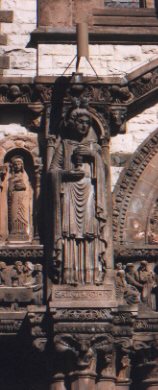
HOME | Continue HHR TOUR | SHEPLEY | UNION STATION | ADAMS | KS OMANESQUE | CORNERS | GALVESTON | FOR |